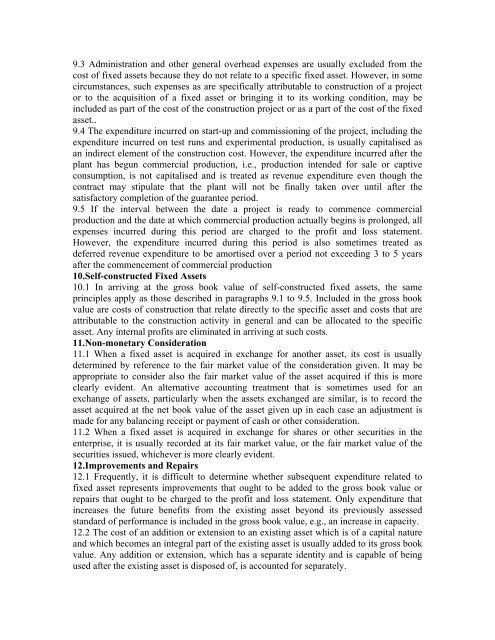Accounting Standards 1-29 - Seth & Associates
Accounting Standards 1-29 - Seth & Associates
Accounting Standards 1-29 - Seth & Associates
Create successful ePaper yourself
Turn your PDF publications into a flip-book with our unique Google optimized e-Paper software.
9.3 Administration and other general overhead expenses are usually excluded from the<br />
cost of fixed assets because they do not relate to a specific fixed asset. However, in some<br />
circumstances, such expenses as are specifically attributable to construction of a project<br />
or to the acquisition of a fixed asset or bringing it to its working condition, may be<br />
included as part of the cost of the construction project or as a part of the cost of the fixed<br />
asset..<br />
9.4 The expenditure incurred on start-up and commissioning of the project, including the<br />
expenditure incurred on test runs and experimental production, is usually capitalised as<br />
an indirect element of the construction cost. However, the expenditure incurred after the<br />
plant has begun commercial production, i.e., production intended for sale or captive<br />
consumption, is not capitalised and is treated as revenue expenditure even though the<br />
contract may stipulate that the plant will not be finally taken over until after the<br />
satisfactory completion of the guarantee period.<br />
9.5 If the interval between the date a project is ready to commence commercial<br />
production and the date at which commercial production actually begins is prolonged, all<br />
expenses incurred during this period are charged to the profit and loss statement.<br />
However, the expenditure incurred during this period is also sometimes treated as<br />
deferred revenue expenditure to be amortised over a period not exceeding 3 to 5 years<br />
after the commencement of commercial production<br />
10.Self-constructed Fixed Assets<br />
10.1 In arriving at the gross book value of self-constructed fixed assets, the same<br />
principles apply as those described in paragraphs 9.1 to 9.5. Included in the gross book<br />
value are costs of construction that relate directly to the specific asset and costs that are<br />
attributable to the construction activity in general and can be allocated to the specific<br />
asset. Any internal profits are eliminated in arriving at such costs.<br />
11.Non-monetary Consideration<br />
11.1 When a fixed asset is acquired in exchange for another asset, its cost is usually<br />
determined by reference to the fair market value of the consideration given. It may be<br />
appropriate to consider also the fair market value of the asset acquired if this is more<br />
clearly evident. An alternative accounting treatment that is sometimes used for an<br />
exchange of assets, particularly when the assets exchanged are similar, is to record the<br />
asset acquired at the net book value of the asset given up in each case an adjustment is<br />
made for any balancing receipt or payment of cash or other consideration.<br />
11.2 When a fixed asset is acquired in exchange for shares or other securities in the<br />
enterprise, it is usually recorded at its fair market value, or the fair market value of the<br />
securities issued, whichever is more clearly evident.<br />
12.Improvements and Repairs<br />
12.1 Frequently, it is difficult to determine whether subsequent expenditure related to<br />
fixed asset represents improvements that ought to be added to the gross book value or<br />
repairs that ought to be charged to the profit and loss statement. Only expenditure that<br />
increases the future benefits from the existing asset beyond its previously assessed<br />
standard of performance is included in the gross book value, e.g., an increase in capacity.<br />
12.2 The cost of an addition or extension to an existing asset which is of a capital nature<br />
and which becomes an integral part of the existing asset is usually added to its gross book<br />
value. Any addition or extension, which has a separate identity and is capable of being<br />
used after the existing asset is disposed of, is accounted for separately.




